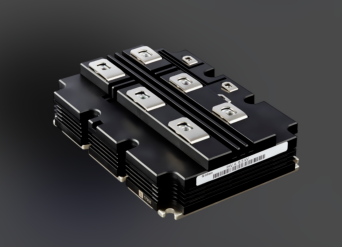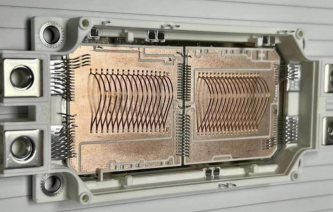ABOUT
What are the applications of Al SiC composites?
Application of Aluminum Silicon Carbide (AlSiC) Substrates in IGBTs

IGBTs, as power semiconductor devices, are widely used in new energy vehicles, white goods, rail transit, clean power generation, smart grids, and other fields. The internal structure of an IGBT module primarily consists of a chip, a ceramic copper-clad substrate, bonding wires, a baseplate, a heat sink, thermal adhesive, solder layer, silicone gel, and a plastic package. Heat dissipation in high-power IGBTs has always been a major obstacle to IGBT development.
The baseplate in an IGBThttps://tungstenchina.com/product/high-silicon-aluminum-alloy-alsic/ module creates a heat conduction path, ensures thermal conductivity, and enhances the module’s mechanical properties. Baseplate materials are typically copper or aluminum-based silicon carbide (AlSiC). Today, we’ll explore the advantages of AlSiC as an IGBT baseplate.
1. Performance Characteristics of AlSiC
Aluminum silicon carbide (AlSiC) is the abbreviation for aluminum-based silicon carbide particle-reinforced composite material, also known as silicon carbide aluminum or aluminum silicon carbide. Aluminum silicon carbide was initially used in radar chip substrates for US military aircraft, replacing tungsten copper. This substitution resulted in excellent heat dissipation and a 10 kg reduction in overall radar weight, which garnered significant attention.
Due to its unique advantages, AlSiC’s penetration in IGBT baseplates has rapidly increased:
1) AlSiC boasts high thermal conductivity (170-200 W/mK), ten times that of typical packaging materials. This allows for the timely dissipation of heat generated by the chip, improving the reliability and stability of the entire component.
2) AlSiC is a composite material, and its thermal expansion coefficient and other properties can be adjusted by varying its composition. With a tunable thermal expansion coefficient (6.5-9.5 × 10⁻⁶/K), AlSiC’s thermal expansion coefficient is well matched to that of semiconductor chips and ceramic substrates, preventing fatigue failure. It even allows power chips to be mounted directly on AlSiC baseplates.
3) AlSiC is very light, only one-third that of copper, comparable to aluminum, yet boasts bending strength comparable to steel. This makes it superior in seismic performance, surpassing copper baseplates. 4) AlSiC has the highest specific stiffness of all electronic materials, three times that of aluminum, five times that of W-Cu and Kovar, and 25 times that of copper. Furthermore, AlSiC offers better vibration resistance than ceramics, making it a preferred material for harsh environments (such as those exposed to high vibration, such as those in the aerospace and automotive industries).
5) AlSiC can be mass-produced, but the processing technique depends on the silicon carbide content. Processing methods include electro-spark machining, diamond machining, and laser machining.
6) AlSiC can be plated with nickel, gold, tin, and other materials, and its surface can also be anodized.
7) Metallized ceramic substrates can be brazed to plated AlSiC substrates, and printed circuit board cores can be bonded to AlSiC using adhesives or resins.
8) AlSiC itself has good airtightness. However, airtightness after electronic packaging with metal or ceramic depends on appropriate plating and welding.
9) The physical and mechanical properties of AlSiC are isotropic.

2. AlSiC Baseplate Preparation Method
The appropriate preparation process is crucial to the performance of composite materials. In electronic packaging, AlSiC with a SiC volume fraction of 55% to 80% meets the required requirements. The AlSiC baseplate preparation method consists of two steps: SiC preform preparation and molten aluminum alloy infiltration. SiC preform preparation is the first and most important step in preparing AlSiC composite materials. Currently, preform preparation methods primarily include compression molding, powder injection molding (AFT) from the United States, and Quickeset™ injection molding technology from CPC (CPC). Compression molding is suitable for components with simple structures. Its molds are simple to manufacture, easy to operate, with short cycle times, no pollution, and high efficiency, making it suitable for automated production. Molten aluminum alloy infiltration methods primarily include squeeze casting, vacuum pressure infiltration, vacuum-assisted pressure casting, and pressureless infiltration.
3. AlSiC Baseplate Applications in IGBTs
The baseplate is directly connected to the heat sink, and its primary function is heat dissipation. When considering the baseplate material, thermal conductivity and linear expansion coefficient (matching the thermal expansion coefficients of the chip and ceramic substrate) must be considered.
AlSiC combines the advantages of silicon carbide ceramic and aluminum metal: high thermal conductivity, a thermal expansion coefficient that matches the chip, low density, light weight, high hardness, and high bending strength. Therefore, AlSiC’s unique advantages make it an irreplaceable material for high-power electronic packaging.
As shown in the figure, copper has excellent thermal conductivity and is currently commonly used for baseplates to achieve rapid heat dissipation. However, copper’s thermal expansion coefficient is nearly three times that of IGBT chips, significantly reducing reliability in long-term vibration environments, such as in locomotives, electric vehicles, and aircraft. While AlSiC’s thermal conductivity is lower than copper’s, its thermal expansion coefficient is closer to that of the chip and ceramic substrate, effectively improving the module’s thermal cycling resistance. Infineon’s tests have shown that IGBT baseplates made of AlSiC have remained functional and solder joints intact after tens of thousands of thermal cycles.
Keyword:
We Exist to Make Your Projects Successful
Fill out the form below and someone from our team will be in touch with you!
FOTMA Delivers Professional Ultra-Dense Solutions, Lighter on Cost, Heavier on Performance.
Hubei Fotma Machinery Co. Ltd.
Wechat / Whatsapp / Mobile:
+86 13995656368, +86 13907199894
Tel: +86-27-67845266
Email: bunny@fotma.com, export@fotma.com
Address: Guanggu Avenue 52#, Hongshan, Wuhan,
Hubei province, P.R.China. 430074